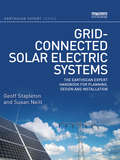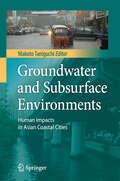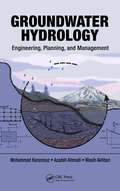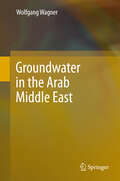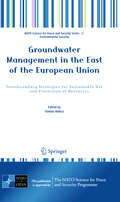- Table View
- List View
Governing Soil Conservation: Thirty Years of the New Decentralization (RFF Agriculture and Fisheries Set)
by Robert J. MorganThis study reviews and evaluates the political and administrative aspects of the nationwide soil conservation effort in the United States. Originally published in 1966
Grain Boundaries and Crystalline Plasticity
by Louisette PriesterThis book explores the fundamental role of grain boundaries in the plasticity of crystalline materials, providing a multi-scale approach to plasticity to facilitate understanding. It starts with the atomic description of a grain boundary, moves on to the elemental interaction processes between dislocations and grain boundaries, and finally shows how the microscopic phenomena influence the macroscopic behaviors and constitutive laws. Drawing on topics from physical, chemical, and mechanical disciplines, this work also explains properties of deformation at low and high temperature, creep, fatigue, and rupture.
Grain Boundaries and Crystalline Plasticity
by Louisette PriesterThis book explores the fundamental role of grain boundaries in the plasticity of crystalline materials, providing a multi-scale approach to plasticity to facilitate understanding. It starts with the atomic description of a grain boundary, moves on to the elemental interaction processes between dislocations and grain boundaries, and finally shows how the microscopic phenomena influence the macroscopic behaviors and constitutive laws. Drawing on topics from physical, chemical, and mechanical disciplines, this work also explains properties of deformation at low and high temperature, creep, fatigue, and rupture.
Granular Computing and Intelligent Systems: Design with Information Granules of Higher Order and Higher Type (Intelligent Systems Reference Library #13)
by Witold Pedrycz Shyi-Ming ChenInformation granules are fundamental conceptual entities facilitating perception of complex phenomena and contributing to the enhancement of human centricity in intelligent systems. The formal frameworks of information granules and information granulation comprise fuzzy sets, interval analysis, probability, rough sets, and shadowed sets, to name only a few representatives. Among current developments of Granular Computing, interesting options concern information granules of higher order and of higher type. The higher order information granularity is concerned with an effective formation of information granules over the space being originally constructed by information granules of lower order. This construct is directly associated with the concept of hierarchy of systems composed of successive processing layers characterized by the increasing levels of abstraction. This idea of layered, hierarchical realization of models of complex systems has gained a significant level of visibility in fuzzy modeling with the well-established concept of hierarchical fuzzy models where one strives to achieve a sound tradeoff between accuracy and a level of detail captured by the model and its level of interpretability. Higher type information granules emerge when the information granules themselves cannot be fully characterized in a purely numerical fashion but instead it becomes convenient to exploit their realization in the form of other types of information granules such as type-2 fuzzy sets, interval-valued fuzzy sets, or probabilistic fuzzy sets. Higher order and higher type of information granules constitute the focus of the studies on Granular Computing presented in this study. The book elaborates on sound methodologies of Granular Computing, algorithmic pursuits and an array of diverse applications and case studies in environmental studies, option price forecasting, and power engineering.
Graphics for Learning: Proven Guidelines for Planning, Designing, and Evaluating Visuals in Training Materials
by Ruth C. Clark Chopeta LyonsAre you getting the most learning value from visuals? Thoroughly revised and updated, Graphics for Learning is the second edition of the bestselling book that summarizes the guidelines for the best use of graphics for instructional materials, including multimedia, texts, working aids, and slides. The guidelines are based on the most current empirical scientific research and are illustrated with a wealth of examples from diverse training materials. The authors show how to plan illustrations for various types of content, including facts, concepts, processes, procedures, and principles. The book also discusses technical and environmental factors that will influence how instructional professionals can apply the guidelines to their training projects. Praise for the First Edition "For years I've been looking for a book that links cognitive research on learning to graphics and instructional design. Here it is! Ruth Clark and Chopeta Lyons not only explain how to make graphics work—they've created a very interesting read, full of useful guidelines and examples." —Lynn Kearny, CPT, instructional designer and graphic communicator, Graphic Tools for Thinking and Learning "Finally! A book that integrates visual design into the larger context of instructional design and development." —Linda Lohr, Ed.D., author, Creating Graphics for Learning and assistant professor, University of Northern Colorado
Graphics for Learning: Proven Guidelines for Planning, Designing, and Evaluating Visuals in Training Materials
by Ruth C. Clark Chopeta LyonsAre you getting the most learning value from visuals? Thoroughly revised and updated, Graphics for Learning is the second edition of the bestselling book that summarizes the guidelines for the best use of graphics for instructional materials, including multimedia, texts, working aids, and slides. The guidelines are based on the most current empirical scientific research and are illustrated with a wealth of examples from diverse training materials. The authors show how to plan illustrations for various types of content, including facts, concepts, processes, procedures, and principles. The book also discusses technical and environmental factors that will influence how instructional professionals can apply the guidelines to their training projects. Praise for the First Edition "For years I've been looking for a book that links cognitive research on learning to graphics and instructional design. Here it is! Ruth Clark and Chopeta Lyons not only explain how to make graphics work—they've created a very interesting read, full of useful guidelines and examples." —Lynn Kearny, CPT, instructional designer and graphic communicator, Graphic Tools for Thinking and Learning "Finally! A book that integrates visual design into the larger context of instructional design and development." —Linda Lohr, Ed.D., author, Creating Graphics for Learning and assistant professor, University of Northern Colorado
The Great Glen: From Columba To Telford
by Catriona FfordeThis book provides a picture of the Great Glen, stretching from Fort William to Inverness, from AD550 to 1850. It begins with a description of the glen as it is today and an account of its geological development. This is followed by eleven chapters describing major characters or events in the glen. These are: St. Columba, King Brude, Macbeth, Alasdair Carrach (an early chief of the Keppoch MacDonalds), the Battle of the Shirts, the 1st Marquis of Montrose, Sir Ewen Cameron of Lochiel, Viscount (Bonnie) Dundee, the building of the Military Roads, the 1745 Jacobite Rising and its aftermath and the building of the Caledonian Canal. There is a short final chapter which makes some reference to the poets and musicians of the glen. Brief passages throughout on political and social developments serve to link the chapters together. The book is academic to some degree but perfectly comprehensible to the general reader with any interest in history. It will be particularly welcome to the hundreds of people who walk the Great Glen Way each year.
Green Corrosion Inhibitors: Theory and Practice (Wiley Series in Corrosion #10)
by V. S. SastriA book to cover developments in corrosion inhibitors is long overdue. This has been addressed by Dr Sastri in a book which presents fundamental aspects of corrosion inhibition, historical developments and the industrial applications of inhibitors. The book deals with the electrochemical principles and chemical aspects of corrosion inhibition, such as stability of metal complexes, the Hammett equation, hard and soft acid and base principle, quantum chemical aspects and Hansch' s model and also with the various surface analysis techniques, e.g. XPS, Auger, SIMS and Raman spectroscopy, that are used in industry for corrosion inhibition. The applications of corrosion inhibition are wide ranging. Examples given in this book include: oil and gas wells, petrochemical plants, steel reinforced cement, water cooling systems, and many more. The final chapters discuss economic and environmental considerations which are now of prime importance. The book is written for researchers in academia and industry, practicing corrosion engineers and students of materials science, engineering and applied chemistry.
Green Corrosion Inhibitors: Theory and Practice (Wiley Series in Corrosion #10)
by V. S. SastriA book to cover developments in corrosion inhibitors is long overdue. This has been addressed by Dr Sastri in a book which presents fundamental aspects of corrosion inhibition, historical developments and the industrial applications of inhibitors. The book deals with the electrochemical principles and chemical aspects of corrosion inhibition, such as stability of metal complexes, the Hammett equation, hard and soft acid and base principle, quantum chemical aspects and Hansch' s model and also with the various surface analysis techniques, e.g. XPS, Auger, SIMS and Raman spectroscopy, that are used in industry for corrosion inhibition. The applications of corrosion inhibition are wide ranging. Examples given in this book include: oil and gas wells, petrochemical plants, steel reinforced cement, water cooling systems, and many more. The final chapters discuss economic and environmental considerations which are now of prime importance. The book is written for researchers in academia and industry, practicing corrosion engineers and students of materials science, engineering and applied chemistry.
Green Energy: Basic Concepts and Fundamentals (Progress in Green Energy #1)
by Xianguo LiGreen Energy: Basic Concepts and Fundamentals addresses the need for diversity within energy systems. It focuses on the theme of energy diversity with local resources, and the integration and optimisation of conventional and alternative energy systems. The book provides a summary of the state-of-art knowledge and technology for future energy systems, covering topics such as: • green energy carriers; • emission control, reduction, and abatement; • energy conversation and management; and • energy environment interaction. This first book in the Progress in Green Energy series will be of value to energy researchers, technology developers and professionals from policy makers to engineers, as well as to advanced undergraduate and postgraduates studying in the field.
Green IT: Technologies and Applications
by Jae H. Kim Myung J. LeeThis book is the first of its kind in presenting comprehensive technical issues and solutions for rapidly growing Green IT. It brings together in a single volume both green communications and green computing under the theme of Green IT, and presents exciting research and developments taking place therein in a survey style. Written by the subject matter experts consisting of an international team of recognized researchers and practitioners in the field, Green IT: Technologies and Applications will serve as an excellent source of information on the latest technical trend of Green IT for graduate/undergraduate students, researchers, engineers, and engineering managers in the IT (Electrical, Communications, Computer Engineering, Computer Science, Information Science) as well as interdisciplinary areas such as sustainability, environment, and energy. The book comprises three parts: Green Communications, Green Computing, and Smart Grid and Applications. Part I Green Communications deals with energy efficient architectures and associated performance measures in wireless communications. It covers energy issues in PHY, MAC, Routing, Application layers and their solutions for a variety of networks. Part II Green Computing deals with various energy issues in data centers, computing clusters, computing storage, and associated optimization techniques. Energy management strategies are presented to balance between energy efficiency and required qualities of services. Part III Smart Grid and Applications presents an overview and research challenges for smart grid. Applications include modeling of urban pollutant for transportation networks, Wireless Sensor Network (WSN) architecture with long range radio, and Green IT standards.
Green Nanotechnology: Solutions for Sustainability and Energy in the Built Environment
by Geoffrey B. Smith Claes-Goran S. GranqvistA first step in developing a clean and sustainable future is to think differently about everyday products, in particular how they influence energy use. Green Nanotechnology: Solutions for Sustainability and Energy in the Built Environment explores the science and technology of tiny structures that have a huge potential to improve quality of life wh
Green Polymerization Methods: Renewable Starting Materials, Catalysis and Waste Reduction
by Robert T. Mathers Michael A. R. MeierDesigning polymers and developing polymerization processes that are safe, prevent pollution, and are more efficient in the use of materials and engergy is an important topic in modern chemistry. Today, green polymer research can be seen increasingly in academia nd industry. It tackles all aspects of polymers and polymerization - everything from chemical feedstocks, synthetic pathways, and reaction media to the nature of the final polymer as related to its inherent nontoxicity or degradability. This book summarizes and evaluates the latest developments in green polymerization methods. Specifically, new catalytic methods and processes which incorporate renewable resources will be discussed by leading experts in the field of polymer chemistry. This book is a must-have for Polymer Chemists, Chemists Working with/on Organometallics, Biochemists, Physical Chemists, Chemical Engineers, Biotechnologists, Materials Scientists, and Catalytic Chemists.
Green Polymerization Methods: Renewable Starting Materials, Catalysis and Waste Reduction
by Robert T. Mathers Michael A. R. MeierDesigning polymers and developing polymerization processes that are safe, prevent pollution, and are more efficient in the use of materials and engergy is an important topic in modern chemistry. Today, green polymer research can be seen increasingly in academia nd industry. It tackles all aspects of polymers and polymerization - everything from chemical feedstocks, synthetic pathways, and reaction media to the nature of the final polymer as related to its inherent nontoxicity or degradability. This book summarizes and evaluates the latest developments in green polymerization methods. Specifically, new catalytic methods and processes which incorporate renewable resources will be discussed by leading experts in the field of polymer chemistry. This book is a must-have for Polymer Chemists, Chemists Working with/on Organometallics, Biochemists, Physical Chemists, Chemical Engineers, Biotechnologists, Materials Scientists, and Catalytic Chemists.
A Green Vitruvius: Principles and Practice of Sustainable Architectural Design
by Vivienne Brophy J Owen Lewis2000 years ago the roman architect Marcus Vitruvius Pollio wrote the ten books on architecture establishing the concept of the pattern book offering design principles and solutions that is still referred to in every architect's education. A Green Vitruvius is intended as a green pattern book for today. Now fully updated, this well established textbook provides advice suitable for undergraduate and post graduate students on the integration of sustainable practice into the design and construction process, the issues to be considered, the strategies to be adopted, the elements of green design and design evaluation within the process. Classic design elegance is found in the holistic clear solution.
A Green Vitruvius: Principles and Practice of Sustainable Architectural Design
by Vivienne Brophy J Owen Lewis2000 years ago the roman architect Marcus Vitruvius Pollio wrote the ten books on architecture establishing the concept of the pattern book offering design principles and solutions that is still referred to in every architect's education. A Green Vitruvius is intended as a green pattern book for today. Now fully updated, this well established textbook provides advice suitable for undergraduate and post graduate students on the integration of sustainable practice into the design and construction process, the issues to be considered, the strategies to be adopted, the elements of green design and design evaluation within the process. Classic design elegance is found in the holistic clear solution.
Greenhouse Gas Inventories: Dealing With Uncertainty
by Thomas White Matthias Jonas Zbigniew Nahorski Sten NilssonThe assessment of greenhouse gases emitted to and removed from the atmosphere is high on the international political and scientific agendas. Growing international concern and cooperation regarding the climate change problem have increased the need for policy-oriented solutions to the issue of uncertainty in, and related to, inventories of greenhouse gas (GHG) emissions. The approaches to addressing uncertainty discussed here reflect attempts to improve national inventories, not only for their own sake but also from a wider, systems analytical perspective — a perspective that seeks to strengthen the usefulness of national inventories under a compliance and/or global monitoring and reporting framework. These approaches demonstrate the benefits of including inventory uncertainty in policy analyses. The authors of the contributed papers show that considering uncertainty helps avoid situations that can, for example, create a false sense of certainty or lead to invalid views of subsystems. This may eventually prevent related errors from showing up in analyses. However, considering uncertainty does not come for free. Proper treatment of uncertainty is costly and demanding because it forces us to make the step from “simple to complex” and only then to discuss potential simplifications. Finally, comprehensive treatment of uncertainty does not offer policymakers quick and easy solutions.
Greening Airports: Advanced Technology and Operations (Green Energy and Technology)
by Milan JanićGreening Airports considers the “greening”, i.e., more sustainable development, of the entire air transport system – airports, air traffic control, and airlines – that could be achieved by the development and implementation of advanced operations and technologies. A broad overview of the general concept is given at the start of Greening Airports, which then goes on to provide a system for monitoring and assessing the level of greening of both the air transport system and individual airports. These are followed by analysis and modelling of the potential effects of particular advanced operations and technologies on the greening of airports and their local airspace. These include:the development of a large airport into a multimodal transport node by connecting it to a high speed rail network;the use of operations supported by new and existing air traffic control technologies to increase landing capacity of existing runways;the use of liquid hydrogen as a commercial aviation fuel; andthe improvement of airport ground accessibility by a light rail rapid transit system. Greening Airports is written for researchers, planners, operators and policy makers in air transport.
Grey Systems: Theory and Applications (Understanding Complex Systems)
by Sifeng Liu Jeffrey Yi ForrestDue to inherent limitations in human sensing organs, most data collected for various purposes contain uncertainties. Even at the rare occasions when accurate data are available, the truthful predictions derived on the data tend to create chaotic consequences. So, to effectively process and make sense out of available data, we need methods to deal with uncertainty inherently existing inside the data. The intent of this monograph is to explore the fundamental theory, methods, and techniques of practical application of grey systems theory, initiated by Professor Deng Julong in 1982. This volume presents most of the recent advances of the theory accomplished by scholars from around the world. From studying this book, the reader will not only acquire an overall knowledge of this new theory but also be able to follow the most current research activities. All examples presented are based on practical applications of the theory when urgent real-life problems had to be addressed. Last but not the least, this book concludes with three appendices. The first one compares grey systems theory and interval analysis while revealing the fact that interval analysis is a part of grey mathematics. The second appendix presents an array of different approaches of studying uncertainties. And, the last appendix shows how uncertainties appear using general systems approach.
Grid-connected Solar Electric Systems: The Earthscan Expert Handbook for Planning, Design and Installation (Earthscan Expert)
by Geoff Stapleton Susan NeillSolar electricity – or photovoltaics (PV) – is the world's fastest growing energy technology. It can be used on a wide variety of scales, from single dwellings to utility-scale solar farms providing power for whole communities. It can be integrated into existing electricity grids with relative simplicity, meaning that in times of low solar energy users can continue to draw power from the grid, while power can be fed or sold back into the grid at a profit when their electricity generation exceeds the amount they are using. The falling price of the equipment combined with various incentive schemes around the world have made PV into a lucrative low carbon investment, and as such demand has never been higher for the technology, and for people with the expertise to design and install systems. This Expert handbook provides a clear introduction to solar radiation, before proceeding to cover: electrical basics and PV cells and modules inverters design of grid-connected PV systems system installation and commissioning maintenance and trouble shooting health and safety economics and marketing. Highly illustrated in full colour throughout, this is the ideal guide for electricians, builders and architects, housing and property developers, home owners and DIY enthusiasts, and anyone who needs a clear introduction to grid-connected solar electric technology.
Grid-connected Solar Electric Systems: The Earthscan Expert Handbook for Planning, Design and Installation (Earthscan Expert)
by Geoff Stapleton Susan NeillSolar electricity – or photovoltaics (PV) – is the world's fastest growing energy technology. It can be used on a wide variety of scales, from single dwellings to utility-scale solar farms providing power for whole communities. It can be integrated into existing electricity grids with relative simplicity, meaning that in times of low solar energy users can continue to draw power from the grid, while power can be fed or sold back into the grid at a profit when their electricity generation exceeds the amount they are using. The falling price of the equipment combined with various incentive schemes around the world have made PV into a lucrative low carbon investment, and as such demand has never been higher for the technology, and for people with the expertise to design and install systems. This Expert handbook provides a clear introduction to solar radiation, before proceeding to cover: electrical basics and PV cells and modules inverters design of grid-connected PV systems system installation and commissioning maintenance and trouble shooting health and safety economics and marketing. Highly illustrated in full colour throughout, this is the ideal guide for electricians, builders and architects, housing and property developers, home owners and DIY enthusiasts, and anyone who needs a clear introduction to grid-connected solar electric technology.
Groundwater and Subsurface Environments: Human Impacts in Asian Coastal Cities
by Makoto TaniguchiExcessive groundwater pumping, groundwater contamination, and subsurface thermal anomalies have occurred frequently in Asian coastal cities, greatly disturbing the urban aquifer and the subsurface environment. In this volume, the relationship between the stage of a city’s development and subsurface environment issues have been explored. Intensive field surveys were done in Tokyo, Osaka, Seoul, Taipei, Bangkok, Jakarta, and Manila. New, advanced methods, including satellite, tracer techniques, and the social economy model, were developed to evaluate subsurface conditions. Groundwater storage and groundwater recharge rates, as well as the accumulation and transport of pollutants, have been compiled as integrated indices of natural capacities under climate and social changes, and used to evaluate the vulnerability risk for all cities. The indices have been made on a yearly basis for seven cities for a century (1900–2000). Using these indicators it is now possible to manage groundwater resources in a sustainable fashion. This volume is indispensable to researchers in hydrology, coastal oceanography, civil engineering, urban geography, social economy, climatology, geothermics, and urban management.
Groundwater Hydrology: Engineering, Planning, and Management
by M. KaramouzIncreasing demand for water, higher standards of living, depletion of resources of acceptable quality, and excessive water pollution due to urban, agricultural, and industrial expansions have caused intense environmental, social, economic, and political predicaments. More frequent and severe floods and droughts have changed the ability and resilien
Groundwater in the Arab Middle East
by Wolfgang WagnerThe book gives an outline of prevailing hydrogeologic conditions in the Arab Middle East together with the geologic background. Emphasis is given to relationships between the main features influencing the hydrogeologic conditions - regional geologic developments, paleogeographic conditions, morphology, climate and paleo-climate - and the resulting hydrogeologic features: formation of aquifers, distribution of major aquifers, main groundwater flow systems, occurrence of renewable and fossil groundwater. Reported data on hydraulic aquifer parameters, recharge rates and groundwater flow volumes are evaluated with a view to arrive at characteristic values under the specific hydrogeologic and climatic conditions. The area considered covers approximately the Arabian Plate. Information on the following countries is included: Bahrain, Iraq, Jordan, Kuwait, Lebanon, Oman, Qatar, Saudi Arabia, Syria, United Arab Emirates, West Bank and Gaza, Yemen.
Groundwater Management in the East of the European Union: Transboundary Strategies for Sustainable Use and Protection of Resources (NATO Science for Peace and Security Series C: Environmental Security)
by Tomasz NaleczThis volume is the result of work carried out under the NATO SPS Study Pilot Project "Sustainable Use and Protection of Groundwater Resources - Transboundary Water Management." It contains basic information on hydrogeological conditions, groundwater management and monitoring in areas of the Belarus, Lithuanian, Polish and Ukrainian borders, simultaneously borders of the European Union with its eastern partners. In view of the importance of the rational utilization of groundwater reserves, which is essential for our future existence, the book presents recommendations for a united methodology of an integrated groundwater monitoring system in this transnational area. The contributions also cover environmental and surface water issues that have direct effects on groundwater resources. The financial dimension of resource mobilization for environmental projects in Eastern Europe also features as part of a complex project solution.















